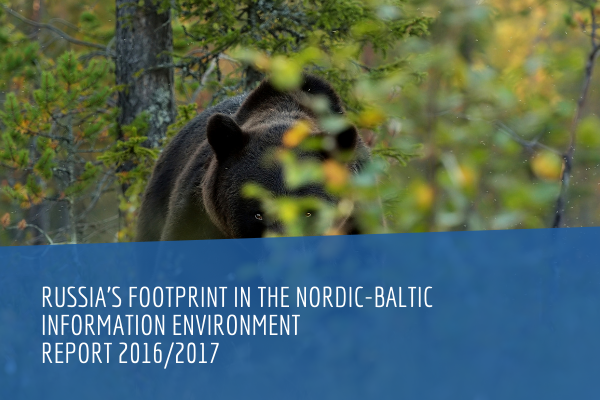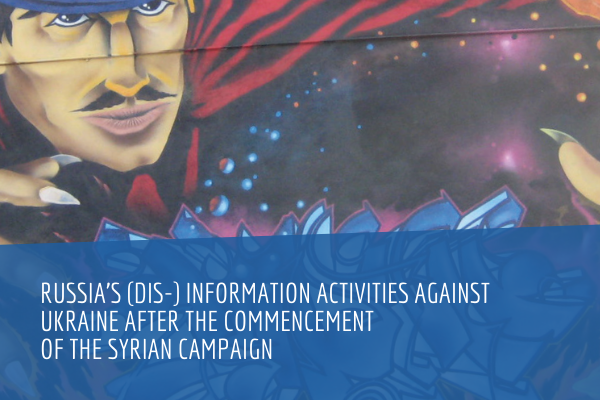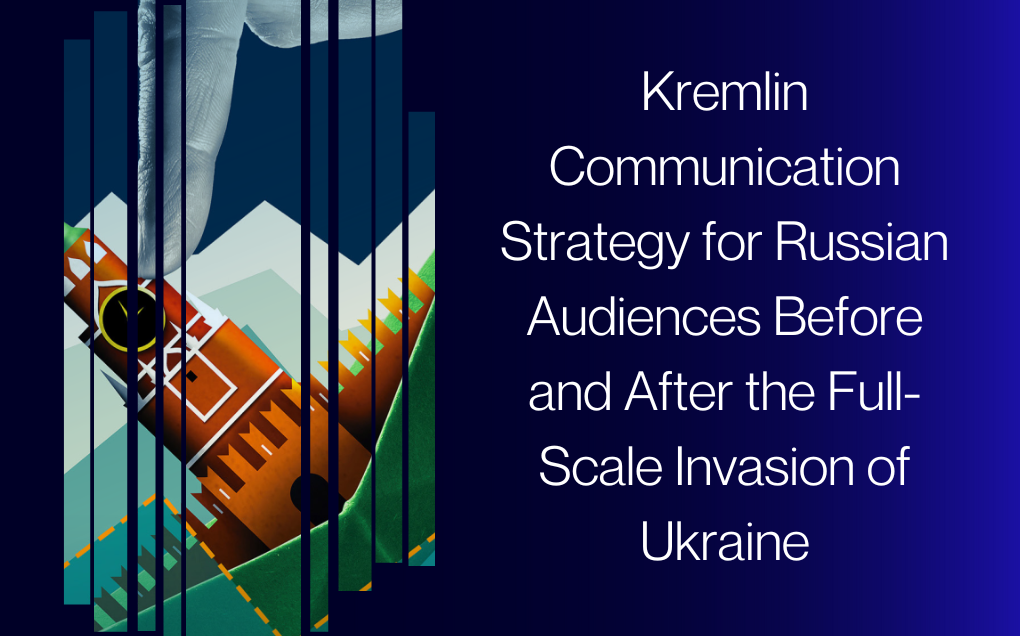This volume presents the first results of the project ‘Russia’s (Dis)Information Activities Against the Nordic-Baltic Region’, which was initiated in 2016 as an ongoing project for monitoring and analysing Russia’s information influence in the Nordic-Baltic region (NB8), which includes Denmark, Estonia, Finland, Iceland, Norway, Latvia, Lithuania, and Sweden. In the period of 2016–2017 four pilot studies were conducted to answer questions about the aims of Russia’s information activities in the region; the use of the ‘compatriot’ policy as a tool of influence; the narratives Russia is using to advance its aims in the NB8 region; how the information provided by Russian state-funded media in some of the NB8 countries is used and how much it is trusted; and about public opinion regarding the narratives Russia promotes in some countries in the region. The main findings are structured around these research questions:
What are the aims of Russia’s information activities in the NB8 region?
- In the political dimension Russia aims to become one of the great powers in the new polycentric world order, to become an equal player in the international system, to challenge the unipolar world order, to counter the post-Cold War interventions of the West, to counter Western liberal democracy as a universal value, to call for the revival of Westphalian sovereignty, and to subvert the unity of the Western states.
- In the military dimension Russia aims to counter NATO expansion towards Russia’s borders and to combine military force with other instruments of power.
- In the economic dimension the Arctic as a region is a priority for Russia, as well as economic interdependence with the other countries in the region.
- In the informational dimension Russia aims to develop its own global media system for the promotion of its worldview, to position itself as a distinct civilization, to support Russian ‘compatriots abroad’, and to develop the concept of the ‘Russian World’—an ideological space that exceeds the territorial boundaries of Russia, as well as to promote its own perspective on Russian and world history.
- The main tools for advancing Russia’s aims are identified as: Russia’s domestic and international media system; the Internet and social media; government-organized non-governmental organizations (GONGOs); Russia’s compatriot policy; pipeline diplomacy; economic interdependency; the encouragement of political radicalization and polarization of Western societies; intelligence operations; and demonstrations of military force.
How is Russia’s compatriot policy being used as a tool of influence in the NB8 region?
- The concept of Russia’s ‘compatriots abroad’ is rather ambiguous and widely interpretable, which gives Russia an opportunity to use the idea of protecting compatriots’ rights as a moral justification for interfering in the internal matters of the sovereign states, for using military force, and for violating the territorial integrity of its neighbouring states.
- However, the number of people who identify themselves as Russia’s compatriots may be at least three times smaller than officially estimated by Moscow. Due to the vagueness of the concept the actual number of compatriots is difficult to verify.
- There is a gap between the scope of Russia’s compatriot policy as it is officially declared and organized and the strength of Russia’s actual relationship with its compatriots abroad. The organization of Russia’s compatriot activities abroad is rather formal, not well known among or representative of Russian speaking communities abroad, and characterized by internal conflicts. As a result, there is no genuine link between Russia and its compatriots abroad, despite an active state policy.
- However, from the perspective of the national security of the NB8 countries, the main concern is not the actual interactions between Russia and its compatriots in the region, but the fact that the narrative of ‘discrimination’ may be used as a political excuse for intervention, as evidenced by the five-day war with Georgia and the crisis in Eastern Ukraine. It may be assumed that Russia exaggerates both the number of its compatriots and the effects of activities to ‘engage’ with them, so that Russia can intervene (if expedient) to ‘protect’ them in a military or non-military manner.
- Latvia and Estonia are the countries most vulnerable to the application of the narrative regarding the violation of the rights of Russia’s compatriots, due to their large number of ethnic Russians and speakers of the Russian language as their first language, and to the phenomenon of ‘non-citizens’—people who immigrated to Latvia or Estonia during the Soviet occupation and could have applied for citizenship through naturalization once these countries regained their independence, but have chosen not to do so.1 If Russia chooses to use this narrative as a basis for violations of sovereignty it will be determined by its strategic interests rather than by any perceived discrimination against Russia’s compatriots, because it is a tool and not a strategic goal.
- The regional coordination of Russia’s compatriot policy began in 2015, when the Regional Coordination Council of the Northern Europe and the Baltic Sea countries was established. From the perspective of coordinating Russia’s compatriot policy, the Baltic States belong to Northern Europe instead of the ‘Near Abroad’.
- The most intensely promoted of Russia’s compatriot activities in the NB8 region is the propagation of Russia’s historical narratives, which are mainly related to the victory of the Soviet Union in World War II. These activities take place in all NB8 countries.
- Marginalizing Russia’s compatriot organizations and activists in the Baltic States reduces the possibility of Russia using them as a ‘soft power tool’. Russia’s opportunities for using soft power have been diminished by the Ukrainian crisis because of the increased wariness towards such activities.
What narratives is Russia using to advance its goals in the NB8 region?
- There were regional differences in terms of the application of certain narratives in relation to the NB8 countries by RT, Sputnik, and Perviy kanal in 2016. Regarding the Baltic States, Russian media have been most concerned with military issues—the two most used narratives were that NATO is a threat to Russia and that the idea of a Russian threat to the West is ridiculous. The analysed Russian media were more concerned with NATO and the activities of the alliance close to its borders, rather than specific issues within the Baltic States.
- The most common narratives in relation to the Nordic countries were that refugees and migrants are a destabilising factor, and such related narratives as radical Islam is a destabilising factor and far-right nationalism is on the rise, which provide evidence that Russia is attempting to amplify the destructive processes caused by the refugee crisis within Europe.
- Another common narrative that emerged in the context of the Nordic countries was that the Arctic is a territory of dialogue, which is, that the interests of Russia and the Nordic countries overlap in this region and Russia’s intention is to solve these issues by peaceful negotiation, as stated in Russia’s Foreign Policy Concept.
- Apart from these common regional trends, there were also some country-specific narratives. In the case of Latvia, the second most common narrative was discrimination against minorities. Estonia and Latvia have similar issues with their ethnic Russian population; nevertheless, in the case of Estonia the discrimination narrative was observed only three times, whereas there were more than 20 discrimination-related articles about Latvia. These data show that Latvia is the main target for the application of the discrimination against minorities narrative.
-
Norway and Iceland were used as role models in the context of the Brexit referendum, suggesting that these countries may do better without the EU and thus strengthening the narrative of diminishing unity in the EU.
-
The second most common narrative in relation to Finland was that Finland and Russia are good partners, no matter what. This is indicative of Russia’s attempt to build and strengthen bilateral relations with European countries.
-
Sweden stood out with the narrative Sweden is part of an unjust persecution of Julian Assange, showing how important the issues related to the WikiLeaks founder are for Russia.
How useful and how trusted is the information provided by Russian state-funded media in the Baltic States, Finland, and Sweden?
- In the states surveyed, the use of Russia’s global media outlets RT and Sputnik is limited. The general trend is that the majority of communities in the Baltic States are aware of these Russian media outlets, but do not use them (more than 60%), whereas most communities in Finland and Sweden are not aware of these media at all (more than 50%).
- Of the Russian media included in the survey, Perviy kanal is the most influential in terms of the audience numbers reached, albeit there are regional differences. An average of 38% of respondents in the Baltic States reported watching Perviy kanal, whereas the majority of respondents in Finland (83%) and Sweden (67%) were not aware of the media outlet.
- The demographic profile of the Russian media users surveyed gives evidence that the use of RT and Perviy kanal (the use of Sputnik is so small that it is impossible to make any analysis of the demographic profile of its users within this survey) is linked to the use of the Russian language, thus making these Russian media outlets an integral part of the so called ‘Russian World’.
- The results of the survey also give evidence that Russia is not a trusted source of information in the Baltic States, Finland, and Sweden, except among a part of Russian speaking audiences in the Baltic States.
What is the public opinion about the narratives promoted by Russia in the Baltic States, Finland, and Sweden?
- The main finding in relation to public opinion is that if the views of the respondents overlap with the narratives promoted by the Kremlin, this overlap is not correlated with the use RT, Sputnik, and Perviy kanal. It is necessary to understand that due to methodological constraints and the existence of other determinants for public opinion that were not researched in this study, the overlap between reported opinions and the Kremlin’s narratives may not be interpreted as the result of Russia’s influence.
- The narrative refugees and immigrants are a destabilising factor for Europe gained the most support in Estonia (77% fully agree & agree somewhat) and Latvia (72% fully agree & agree somewhat). In Lithuania and Finland support for the statement was somewhat smaller, albeit still high—69% and 63% of those who agree fully and somewhat, but in Sweden this statement gained the least support—only 46% of respondents agreed fully and somewhat.
- The highest support for the narrative that a rebirth of neo-Nazism is taking place in Europe was identified in Sweden (74% fully agree & agree somewhat) and Finland (65% fully agree & agree somewhat)—the countries where consumption of RT, Sputnik, and Perviy kanal was the smallest.
- The answers given by respondents about the narrative Russian speaking people in Latvia experience discrimination indicate that there is little interest regarding this issue in the neighbouring countries—29% of respondents in Lithuania, 30% in Finland, 41% in Estonia, and 60% in Sweden answered that they have no opinion about it. Respondents in Latvia have a strong resistance to this narrative—54% fully disagreed with the statement and 20% disagreed somewhat (74% of all respondents disagreed).
- The response to the question regarding the narrative that Sweden is part of the unjust persecution of WikiLeaks founder Julian Assange suggests that some of the narratives Russia is promoting are not at all important for the people of the surveyed countries, as 70% of respondents in Latvia, 69% in Lithuania, 63% in Estonia, 41% in Sweden, and 22% in Finland have no opinion about this issue.
-
NATO is one topic that polarizes opinion in the Baltic States between those who use Russian as their first language and the titular nationalities. The general trend is that titular nationalities are more supportive of a NATO presence in their countries. Therefore the most surprising results in relation to the narrative NATO is a threat to Russia are found in Latvia, because 45% of respondents fully disagree and 23% disagree somewhat (in total—68%) with the statement, despite the demographics and the high consumption of Russian media in the country.






